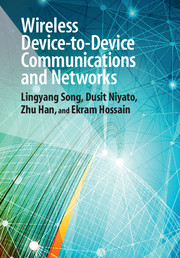Book contents
- Frontmatter
- Dedication
- Contents
- Preface
- Part I Introduction
- Part II Techniques for modeling and analysis of D2D communications
- Part III Resource management, cross-layer design, and security for D2D communications
- Part IV Applications of D2D communications
- 9 Vehicular ad-hoc networks
- 10 Mobile social networks
- 11 Machine-to-machine (M2M) communications
- Part V Standardization of D2D communications
- References
- Index
11 - Machine-to-machine (M2M) communications
from Part IV - Applications of D2D communications
Published online by Cambridge University Press: 05 March 2015
- Frontmatter
- Dedication
- Contents
- Preface
- Part I Introduction
- Part II Techniques for modeling and analysis of D2D communications
- Part III Resource management, cross-layer design, and security for D2D communications
- Part IV Applications of D2D communications
- 9 Vehicular ad-hoc networks
- 10 Mobile social networks
- 11 Machine-to-machine (M2M) communications
- Part V Standardization of D2D communications
- References
- Index
Summary
Introduction
Wireless connectivity is rapidly expanding beyond traditional mobile devices used by humans. In the near future, many wireless devices (e.g., sensors and actuators) will be connected in the framework of the Internet-of-Things (IoT) [363]. In cellular networks, hundreds or thousands of devices can exist in one cell. Therefore, the concept of machine-to-machine (M2M) communications has been introduced to handle the transmission of a number of devices in the network. M2M communication, also known as machine-type communications (MTC), refers to mobile nodes communicating over a network without (or with minimal) human intervention. M2M communication enables ubiquitous connectivity among autonomous devices and/or Internet connectivity of MTC devices (i.e., communications between an MTC device and an M2M server or between two MTC devices). M2M communication is different from human-to-human (H2H) communication, which mainly involves voice calls, messaging, and web browsing. The goal of M2M communications is to increase the level of system automation by allowing the devices and systems to exchange and share data. Therefore, the protocol and data format are the major issues in M2M communications owing to the need to ensure seamless data and control flows.
D2D communication can be considered as a type of M2M communication when the D2D user equipments UEs are in close proximity and have small amounts of data to transmit among themselves (e.g., in application scenarios relating to the control of appliances in the home). In this chapter, we provide an overview of M2M communications in Section 11.2. Specifically, we focus on MTC in Long Term Evolution (LTE) and LTE-Advanced (LTE-A). Section 11.3 presents the mechanisms to support MTC, i.e., a random-access (RA) procedure and random-access-channel (RACH)-overload control mechanisms. Section 11.4 introduces a performance-modeling technique based on queueing theory to analyze the performance of the RA mechanism for M2M communications. Finally, Section 11.5 gives a summary of the chapter and lists some important research directions.
Machine-to-machine (M2M) communications
M2M communication, which is undergoing the process of standardization by the Third Generation Partnership Project (3GPP), can support a wide range of applications (e.g., secured access and surveillance, metering and smart grid, and Internet-of-Things).
Information
- Type
- Chapter
- Information
- Wireless Device-to-Device Communications and Networks , pp. 338 - 368Publisher: Cambridge University PressPrint publication year: 2015
